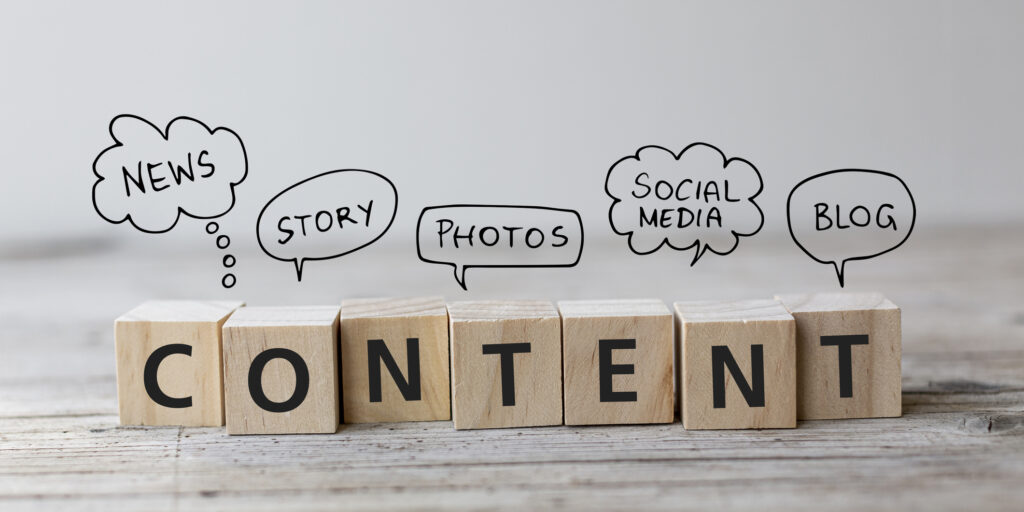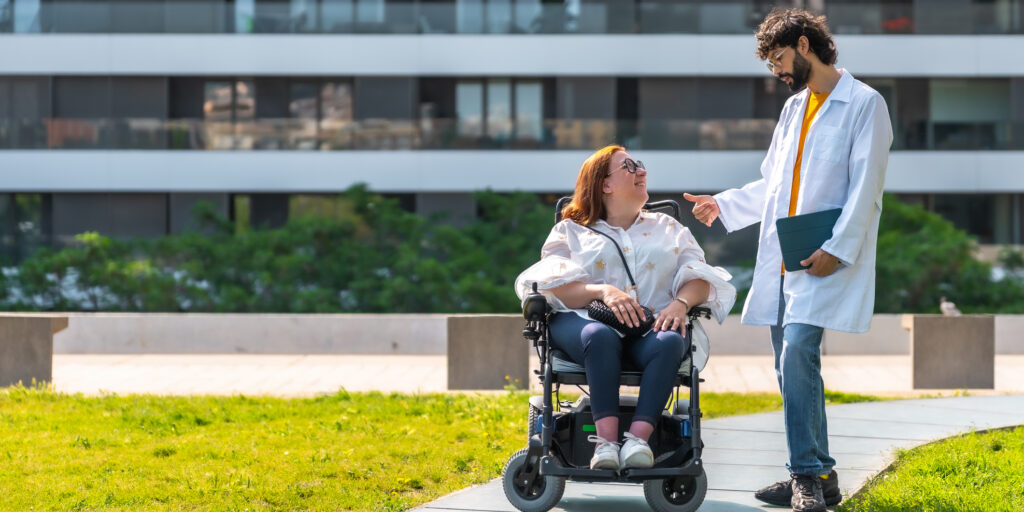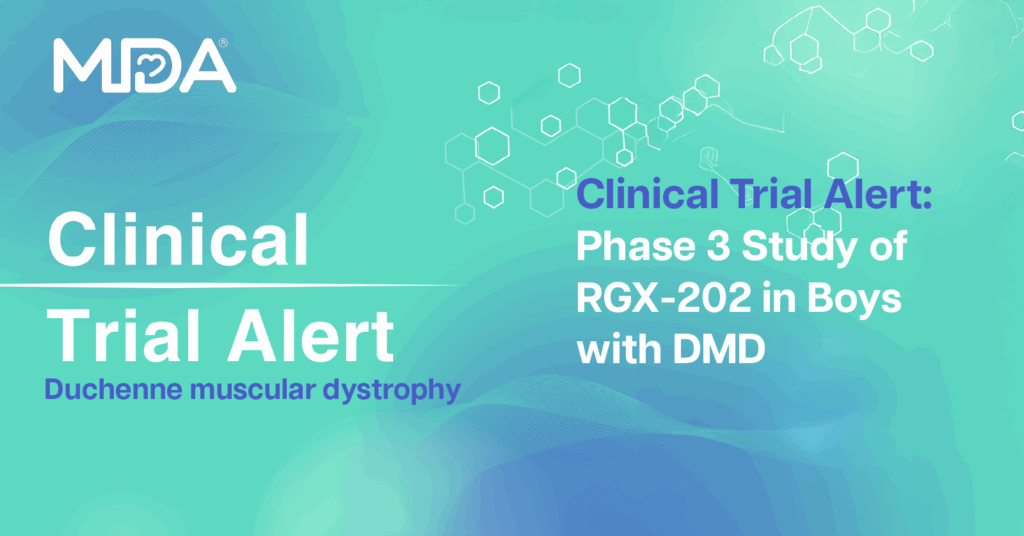![GENE GettyImages-1551445063 [Converted] Illustration of a man walking into a DNA helix-shaped hedge maze.](https://mdaquest.org/wp-content/uploads/2024/08/GENE-TW-GettyImages-1551445063-Converted-e1723464415811.jpg)
Are You Ready for Gene Therapy? Here’s What You Need to Know
By Larry Luxner | Tuesday, August 13, 2024
5 Second Summary
Gene therapies are increasingly available for muscular dystrophies and other neuromuscular diseases. My Gene Therapy Journey is a Quest Media series that gives members of the neuromuscular community a platform to share their experiences with gene therapies — both approved therapies and those in clinical trials — and provides essential information to help individuals and families make decisions about gene therapies.
When Marie Bedirlian’s son Douglas, 6, was diagnosed with Duchenne muscular dystrophy (DMD) as an infant, she thought she knew what to expect. Douglas’s older brother, Brayden, 14, also lives with DMD. At a young age, Brayden couldn’t jump and had trouble running. Later, he started tiring quickly while walking, and at 11, he started using a wheelchair full-time.
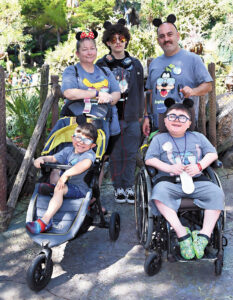
Marie Bedirlian’s sons Douglas (front left) and Brayden (front right) have Duchenne muscular dystrophy.
But in 2023, the US Food and Drug Administration (FDA) approved a gene therapy for DMD in young boys that may delay or halt the progression of the disease. Marie, of Bellflower, California, seized the opportunity for her younger son. On October 24, 2023, Douglas became the second person to receive the newly approved delandistrogene moxeparvovec-rokl (Elevidys®) at the MDA Care Center at Children’s Hospital of Los Angeles.
“My hope was for him to walk, jump, run, and play like any other child his age could do,” Marie says. “And this gene therapy has made that possible, for now.”
In fact, gene therapy is emerging as a promising area of treatment for neuromuscular diseases. However, access to gene therapies depends on many factors, including age, proximity to an infusion center, and insurance approval. As we enter this new era of gene therapy, here’s what individuals with neuromuscular diseases and their families need to know.
Why gene therapy?
Most neuromuscular diseases are caused by genetic mutations. Gene therapy aims to treat a genetic disease at its source by replacing a mutated gene with a working gene, repairing a flawed gene, or altering how a gene is controlled.
So far, gene therapy results have varied, but when it works, the effects can be dramatic. Some children who were identified with spinal muscular atrophy (SMA) through newborn screening and given the gene therapy drug onasemnogene abeparvovec (Zolgensma®) as infants have not developed symptoms of the disease years later. The hope is that they never will.
Zolgensma was approved in 2019 for children under 2 years old with SMA. Elevidys was approved in 2023 for boys 4 and 5 years old with DMD, and the approval was expanded in June 2024 to ages 4 and older. These are currently the only two gene therapies approved for neuromuscular diseases. However, many more are being tested to treat diseases such as amyotrophic lateral sclerosis (ALS), Charcot-Marie-Tooth disease (CMT), Friedreich ataxia (FA or FRDA), limb-girdle muscular dystrophy (LGMD), and Pompe disease.
MDA has made key contributions to the gene therapy field that helped lead to these advances, including funding the first muscular dystrophy gene therapy clinical trial in 1998 and the first DMD gene therapy trial in 2006. Many of the gene therapies in clinical trials for neuromuscular diseases in the United States are based on strategies developed with MDA funding.
Researchers expect more approvals in the next few years, and many people will want to know how they can access gene therapies as they become available.
Access to gene therapy
Several factors are involved in who can get gene therapy:
- Diagnosis. Gene therapies are designed to replace or block the function of specific genes. Genetic testing to confirm a genetic diagnosis — or, in some cases, a certain type of gene mutation — is required to qualify for a gene therapy.
- Age. New drugs are tested and approved for specific ages. As with Elevidys, some therapies are initially approved for a narrow age range, but as more data emerge to suggest they are safe and effective in a wider population, that approval may be expanded.
- Preexisting antibodies. Adeno-associated virus (AAV) vectors are the leading platform for delivering gene therapy to cells in the body. Zolgensma and Elevidys both use AAV vectors. AAVs are small, naturally occurring viruses that do not cause sickness in humans and can carry genetic material. However, anyone who has been exposed to an AAV before may have developed some immunity to it. Before receiving a gene therapy that uses an AAV vector, individuals must be tested for antibodies to the virus.
- Cost. The current market price for Zolgensma is $2.1 million, and for Elevidys, $3.2 million. The extensive research involved in developing a new gene therapy and the cost of manufacturing contribute to the price. Health insurance companies require preauthorization before approving coverage for these expensive drugs. “Each insurer is different, and while some cover gene therapy, some don’t,” says Nora Capocci, MDA’s Executive Vice President for Healthcare Services. Because gene therapy is so new, many insurers don’t have policies in place for them and are looking at each case individually. “There have been instances where people have to appeal a decision two or three times,” Nora says.
- Clinical readiness. Not all healthcare facilities have an infusion center with the proper equipment to store gene therapy drugs or staff trained in administering them and monitoring patients afterward. “Families looking to pursue treatment may find that their local hospital or clinic may or may not be prepared to administer gene therapy. That doesn’t mean they won’t be able to get it,” says Crystal Proud, MD, a neurologist at the MDA Care Center at Children’s Hospital of the King’s Daughters in Norfolk, Virginia. Her facility has dosed more than 40 children with Elevidys or Zolgensma. “We’re going to need more collaboration between healthcare centers. Some are very experienced in administering these therapies.”
MDA is playing a role in helping institutions prepare for gene therapies. MDA created the Gene Therapy Support Network to help individuals and families navigate the new landscape and challenges to access. Learn more about this service in “A Partner on the Gene Therapy Journey” below.
Is gene therapy safe and effective?
Nora stresses that while new gene therapies offer incredible promise, “there are no guarantees that gene therapy will improve function or stop progression in any individual.”
“In clinical trials of gene therapies, patients have responded differently in terms of benefits and side effects,” Nora says. “Potential risks, side effects, and expectations of benefit must be thoroughly reviewed with your physician before receiving any gene therapy.”

Laszlo Mechtler, MD
Gene therapy is generally considered safe, but Laszlo Mechtler, MD, director of neurology at the Dent Institute in Buffalo, New York — also an MDA Care Center — notes that all gene therapies have the potential to cause adverse side effects. In clinical trials, serious but rare side effects have included severe immune responses and damage to internal organs, such as the heart and liver. There have been several gene therapy-related deaths in neuromuscular disease trials.
Researchers are continuing to look for ways to make gene therapy safer. For example, in some recent DMD gene therapy trials by Sarepta, Solid Biosciences, and Pfizer, five participants developed immune-mediated myositis, a condition in which the immune system attacks the muscles.
“What was remarkable was how all these pharmaceutical companies got together and pooled their resources to try to figure out what was causing this very serious reaction,” says Omer Abdul Hamid, MD, a pediatric neurologist and Director of the MDA Care Center at Nemours Children’s Hospital in Orlando, Florida. “They found that all five boys had large deletions that included exons 8 and 9.” Based on this finding, they revised the eligibility criteria to exclude individuals with those genetic characteristics from that type of gene therapy.
Dr. Laszlo attempts to put the risks and potential rewards of gene therapy in perspective: “You’re taking a risk, but you’re taking a risk with a progressive disease that has no treatment. When you take chemotherapy for cancer, you’re also taking a risk. This is something the family must consider in their decision-making.”
What to expect
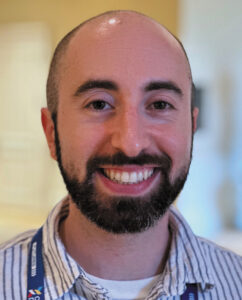
Omer Abdul Hamid, MD
At the MDA Care Center at Nemours Children’s Hospital, Dr. Hamid has dosed children with Elevidys and Zolgensma. Both drugs are given as an intravenous (IV) infusion in a single dose.
Patients usually spend a day at the clinic to receive the infusion and be monitored afterward for adverse reactions. “The IV infusion goes over an hour and a half to two hours. On dosing day, families get there early,” Dr. Hamid says. “In a sense, it’s a very anticlimactic day, although it’s a very important and memorable day for our families.”
Following the infusion, the individual will need blood tests and follow-up visits for months or years to monitor the potential long-term effects of the gene therapy, and they will continue to manage their underlying neuromuscular disease.
Dr. Hamid stresses that gene therapy is a commitment and says that before seeking gene therapy for their child, parents should ask themselves: “Are they ready for the commitment it takes to undergo the frequent lab monitoring, as well as the risks of liver, heart, and other organ injuries? They will need to talk to their provider to see if their child is a good candidate.”
The final consideration is, perhaps, the biggest mystery of all when it comes to gene therapy: How long will it last? Based on animal studies, the answer seems to be at least several years — although the exact duration is unknown and may differ from person to person.
“Factors that determine how long gene therapy will last in the body include the type of cells being treated, age of the patient at dosing, dose level, disease progression, and patient-specific responses,” Nora says.
Gene therapies delivered via AAV, such as Elevidys and Zolgensma, are limited to a single treatment because of current technology and human biology. In 2023, MDA co-funded a project with Parent Project Muscular Dystrophy and CureDuchenne to focus on the hurdles of preexisting antibodies and redosing.
There are many challenges to overcome in developing and accessing gene therapies, but the potential to correct a gene mutation at its source, thus preventing or reversing the effects of a disease, motivates researchers to keep going. MDA is committed to funding gene therapy research and bringing scientists together at its annual Gene Therapy Summit to work through remaining obstacles.
Marie has seen encouraging results since her son Douglas received Elevidys in October 2023. “Within three weeks, we noticed a major difference,” she says. “Before, he couldn’t jump and would get tired easily. To go upstairs, he’d have to hang on and climb up one by one. Now, he gets up in four seconds and is walking normally.”
Larry Luxner is a freelance journalist based in Israel. He writes frequently about rare diseases.
A Partner on the Gene Therapy Journey
MDA created the Gene Therapy Support Network to help individuals and families navigate the new landscape and challenges of accessing gene therapies. It aims to partner with patients and their care teams throughout decision-making, gene therapy treatment, and post-gene therapy care.
The network offers one-on-one video calls, phone calls, or emails to talk with a Gene Therapy Support specialist about anything related to gene therapy. They can connect you to educational materials and resources, as well as to MDA Care Centers and the new Gene Therapy Community Group. Gene Therapy Support specialists are available to answer questions and provide one-on-one support by phone, email, or a scheduled video call.
The Gene Therapy Support Network also serves as a resource for healthcare providers, sharing insights and best practices from clinicians across the MDA Care Center Network who have successfully helped their patients access gene therapy.
To contact the Gene Therapy Support Network, call 833-ASK-MDA1 or email ResourceCenter@mdausa.org.
Next Steps and Useful Resources
- Take MDA’s free online Access Workshop: Access to Gene Therapy. This self-paced course explains gene therapy treatments, the FDA drug approval process, insurance coverage options, and more.
- To learn more about gene therapy and genetic testing for neuromuscular diseases, download MDA’s educational materials.
- Connect with others interested in or going through gene therapy in MDA’s Gene Therapy Community Groups.
- Stay up-to-date on Quest content! Subscribe to Quest Magazine and Newsletter.
TAGS: Drug Development, Featured Content, Gene Therapy, Genetic Testing, Healthcare, MDA Care Centers, My Gene Therapy Journey, Research
TYPE: Featured Article
Disclaimer: No content on this site should ever be used as a substitute for direct medical advice from your doctor or other qualified clinician.


